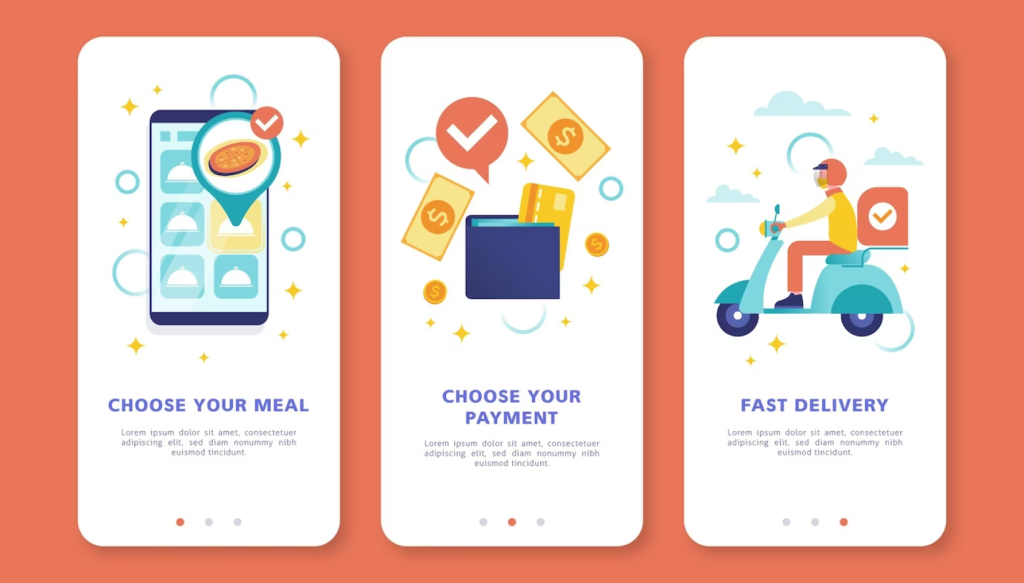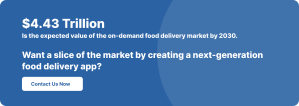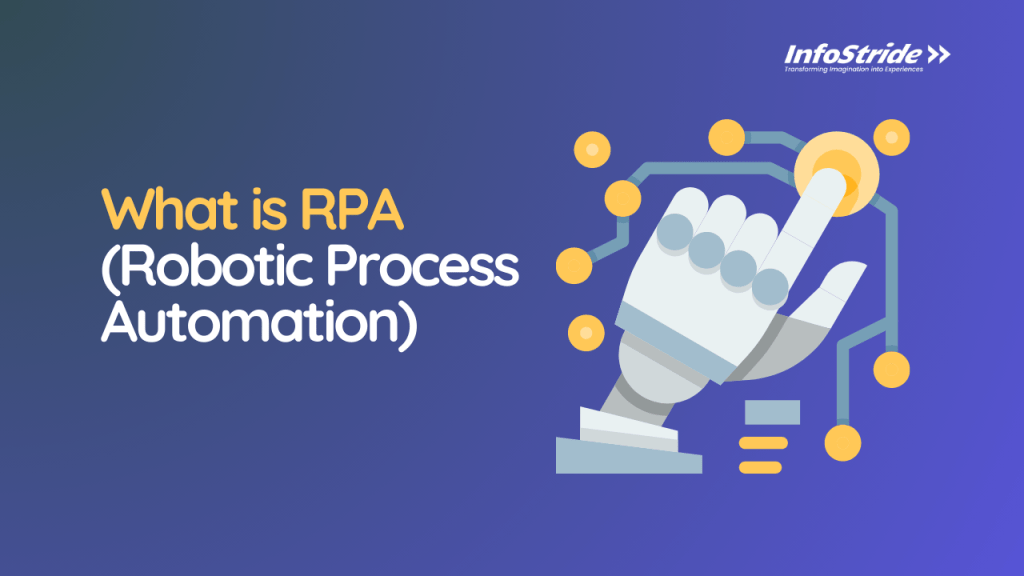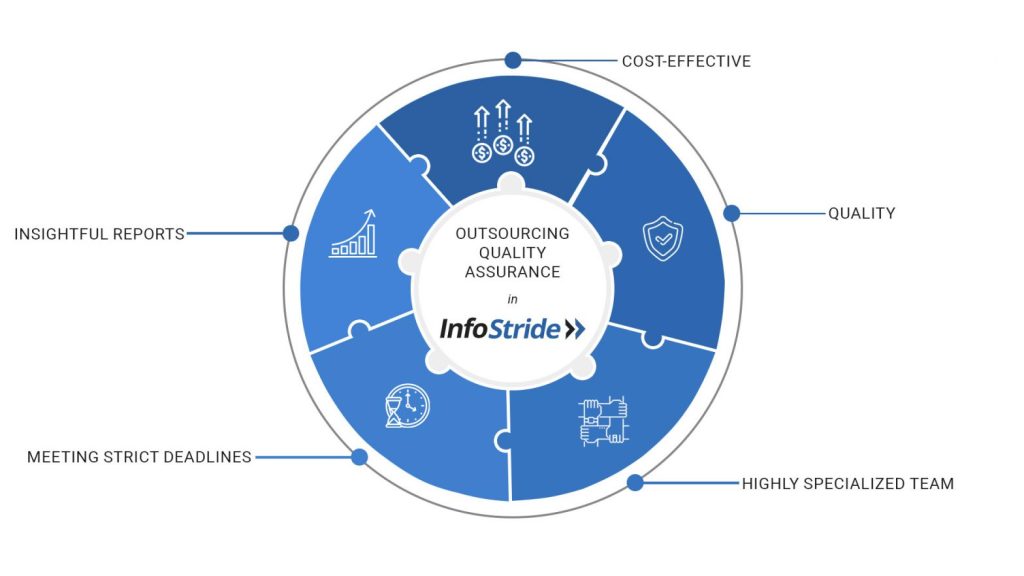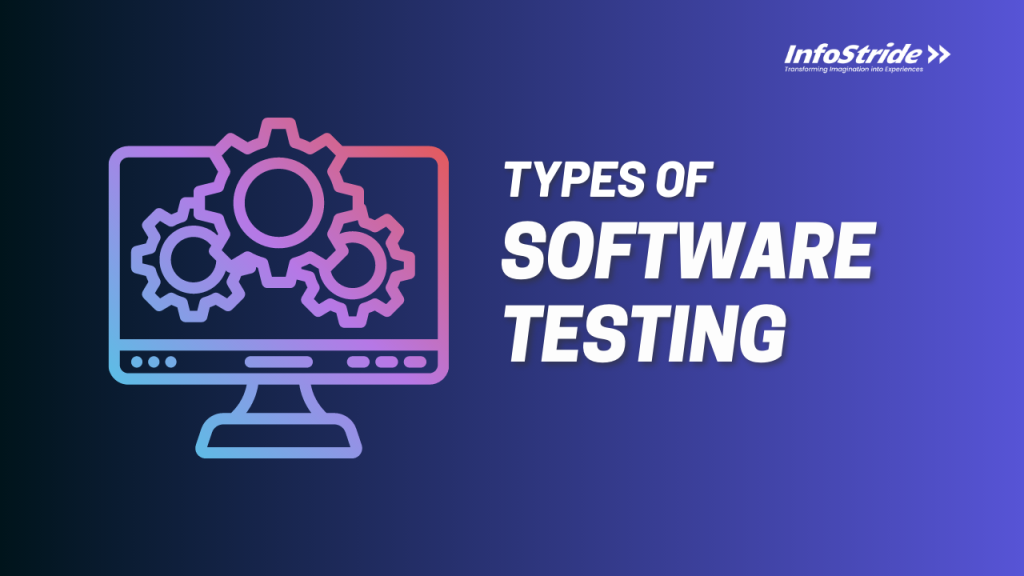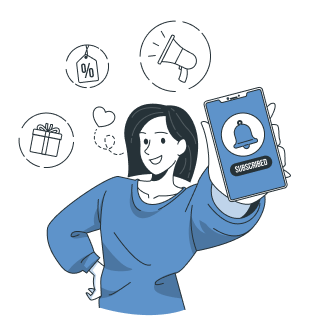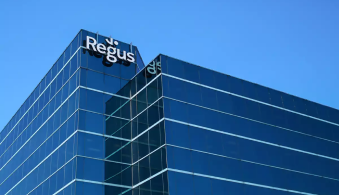Table of Content
Why Investing In On-Demand Food Delivery App Development is a Profitable Business Idea?
Key Players in the On-demand Food App Delivery Industry
3 Popular Business Models of Online Food Delivery Business
Revenue Model of an On-Demand Food Delivery Business
The on-demand app development economy has had a disruptive impact on all industries in recent years and the food industry is no exception. Today, on-demand food delivery apps have become an integral part of modern living, with their widespread popularity and market size continuing to grow.
The size of the global food service market touched 2.52 trillion U.S. dollars in 2021. This figure was anticipated to reach 4.43 trillion U.S. dollars in 2028, at a CAGR of 9.9 percent from 2021 to 2028.

So, what factors contribute to the remarkable success of on-demand food delivery apps?
The primary driver is convenience. In an era characterized by busy schedules and rapid digitalization, these apps offer a quick and effortless way for people to satiate their food cravings without leaving their homes or workplaces. Moreover, the integration of AI and data analytics enables highly personalized experiences suggesting curated food choices that perfectly resonate with their tastes.
With consumers willing to pay more for convenience and a personal touch, aspiring entrepreneurs and startups can leverage this demand and position themselves as key players in this rewarding sector by investing in on-demand food delivery app development.
In this article, we are going to talk about everything related to how to create a food delivery app to help startups get started.
Let’s first start by unveiling all the major reasons to invest in the online food industry.
Why Investing In an On-Demand Food Delivery App Development is a Profitable Business Idea?
The online food industry is a rapidly growing market and there are many reasons why investing in it can be highly profitable. Here are some of the reasons:
-
The market is growing
The online food delivery industry is experiencing exponential growth, making it an opportune space for startups to enter. The global revenue from the online food delivery segment is expected to touch 96,864.4 million USD by 2024. This growth trajectory highlights the immense potential for startups to capture a significant market share.

-
The demand is increasing
Due to the prevalence of smartphones, the growing demand for convenience and the increasing popularity of online ordering, the demand for on-demand food delivery apps is increasing. In fact, a recent study showcases that the number of users in the online food delivery segment is expected to amount to 2.5 billion users by 2027.
-
The barriers to entry are low
The on-demand food delivery industry is known for its low entry barriers, creating an environment that welcomes new startups and players with open arms.
Unlike traditional industries that often require significant upfront investments and complex infrastructures, the digital nature of on-demand food delivery means entrepreneurs can start their food delivery business with relatively little investment.
-
The market is global
The online food delivery market is global, offering startups the opportunity to target both local and international markets, reach a global audience and expand their customer base exponentially. DoorDash is a prominent player in the global food delivery industry, catering to customers across the United States, Canada, and Australia.
-
The revenue streams are diverse
Investing in online food delivery app development offers multiple revenue streams, including delivery fees, subscription models, collaborations with restaurants and in-app advertising. A mix of revenue sources can balance the negative influence of economic fluctuations. While one stream may be affected, others can remain steady, ensuring a more stable revenue flow.
-
The investor interest is increasing
The on-demand food delivery sector has also captured the attention of investors. The industry’s ability to align with changing consumer needs, its tech-savvy approach and its innovative revenue avenues have collectively ignited investor interest.
In 2022, a total of 16,464 venture capital deals were closed in the U.S., showcasing the country’s pivotal role in supporting startup growth and innovation.
Key Players in the On-demand Food App Delivery Industry
The relatively low entry barriers to the industry have led to the emergence of numerous players in the on-demand food delivery app development market. Identifying areas where existing players are not able to fully cater to customer needs can help you find a niche or an underserved market segment to target.

3 Popular Business Models of an Online Food Delivery Business
Deciding on the right business model is an essential first step when launching a new business venture for entrepreneurs. It starts with familiarizing yourself with various online food delivery business models that exist in the market to make a strategic decision.

Here, we’re going to talk about 3 dominant business models prevalent today in the on-demand food delivery app development niche:
-
The Order Only Model
This food delivery business model provides a platform that exclusively focuses on receiving and processing orders from customers, without directly engaging in the delivery process. Instead, the platform acts as a middleman between restaurants and customers.
Examples:
The successful food delivery apps that are built on this business model are Just Eat and Grubhub.
-
The Order and Delivery Model
In this business model, the food delivery platform facilitates the entire process of receiving orders from customers and subsequently delivering those orders to the customers’ doorsteps. Thus, this model involves coordination between the platform, restaurants and delivery personnel to ensure a smooth and timely meal delivery to customers.
Examples:
Prominent examples of platforms using the order and delivery model include Uber Eats, DoorDash, and Grubhub. These platforms connect customers with a variety of local restaurants and manage the entire process from order placement to delivery.
-
The Fully Integrated Model
In this business model, the owner of the food delivery platform manages everything from cooking the meal to delivering it. Thus, this model is ideal for well-established restaurants that already possess an existing delivery infrastructure.
However, it is important to note that this model is the most expensive to operate. If you’re a brand-new restaurant, a cloud or virtual kitchen is a good idea if you want to get started with a small investment.
Examples:
Popular examples of platforms that operate under the fully integrated model are Domino’s and McDonald’s which have complete control over the customer experience.
Revenue Model of an On-Demand Food Delivery Business
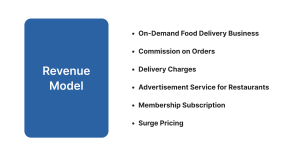
Listed below are several monetization opportunities that entrepreneurs can utilize to generate revenue from their on-demand food delivery platform:
-
Commission on Orders
This is the most common revenue model for food delivery businesses operating under the order only and the order only & delivery business models. The platform charges a commission to the restaurants for each successful order that is placed through the app.
-
Delivery Charges
On-demand food delivery platforms can charge customers a delivery service fee, which contributes to the overall revenue. This fee may vary based on factors such as distance, location and order value.
-
Advertisement
This is also the revenue model ideal for food delivery startups operating under the order only and the order only & delivery business models. The platform can sell advertising space to restaurants or other businesses that want to reach their users.
-
Membership Subscription
On-demand food delivery platforms can offer a subscription-based service where users pay a recurring fee for benefits like free deliveries, exclusive discounts and premium customer support.
-
Surge Pricing
In this revenue model, on-demand food delivery platforms can implement surge pricing during peak hours or busy days, charging customers higher delivery fees during high-demand periods.
How to Create a Food Delivery App? – A Step-by-Step Guide
Taking a systematic approach to on-demand food delivery app development will help you lead to successful outcomes. Here are the steps you can follow to create a food delivery app that stands out in this highly competitive market.
Step 1: Research the market
The first step towards building an on-demand food delivery business application is to perform comprehensive market research.
- Study your key competitors to take inspiration for innovative features, find their strengths & weaknesses and learn from their mistakes.
- Understand how competitors price their services and evaluate different pricing models, such as delivery fees, surge pricing or subscription plans.
- Keep pace with changing customer demands and their purchasing behavior to come up with features that deliver a superior experience to them.
- Research local regulations related to food delivery services, permits, licenses, health and safety standards and any legal requirements for operating a delivery business.
- Study user reviews and feedback on existing platforms to identify pain points, areas of improvement, and features that resonate with customers.
Step 2: Choose the right business model
The next step is to choose the right business model for your on-demand food delivery business. As mentioned before, there are three major business models used by many popular on-demand food delivery apps:

To select a suitable business model for your on-demand food delivery business, evaluate your current resources. Assess your available resources, including a budget, technology infrastructure, delivery fleet and partnerships. Choose a model that suits your resources and strengths.
Step 3: Identify your app functionality and features
Before starting your on-demand food delivery app development, you should also first identify the key features. In the food delivery business, three main types of apps contribute to the overall ecosystem. These apps serve different purposes and cater to various stakeholders involved in the process.
- Customer App
This app allows customers to browse menus, order food and track the progress of their orders. They typically include features such as order placement, real-time tracking ratings & reviews and multiple payment methods.

- Restaurant App

This app allows restaurants to manage incoming orders, update menus, monitor order statuses, and track customer feedback. Overall, the purpose of the app is to streamline restaurant operations.
- Delivery Staff App

This app allows delivery drivers to see their upcoming orders, track their earnings, navigate to customer addresses, communicate with customers and provide real-time updates on order statuses.
Step 4: Work with a tech partner to build an MVP
Choosing the best on-demand food delivery app development company is crucial. The right app development partner can bring advanced knowledge in on-demand app development, ensuring your app is built with a scalable technology architecture and visually appealing interface.
Moreover, a tech partner can help you seamlessly integrate external services like payment gateways, maps and communication APIs for a smooth user journey.
By developing only core features with the MVP app development approach, your food delivery app development company can help you save on development costs and accelerate your time to market for a competitive edge in the market.
Step 5: Deploy, test and scale your app
Once building a minimum viable product and deploying it across target platforms, your online food delivery app development company can help you test and scale it by incorporating feedback from customers. This way, you will be able to create a food delivery app that perfectly resonates with customers’ evolving expectations.
Step 6: Grow your food delivery business
Once the app is launched, you need to focus on growing your food delivery business. This means leveraging data-driven growth marketing strategies to market your app, acquire new users and retain existing users.
How can InfoStride help in creating your food delivery app?
InfoStride is known for delivering custom on-demand food delivery app development services that offer full engineering capabilities from idea conceptualization to design, development, deployment and growth marketing. We have a team of experienced consultants and developers who possess a deep understanding of the on-demand food delivery industry.
Whether you want to create a food delivery app like Uber Eats, DoorDash or Postmates, our experts can guide you through the entire on-demand food delivery app development process and help take your business to the next level. So, get in touch with us.
FAQs
1- What is an on-demand food delivery app?
An on-demand food delivery app is a mobile application that allows users to order food from restaurants in their area and have it delivered right to their doorstep. These apps typically offer a range of restaurant options to choose from and they allow users to filter their search by cuisine, price and other specific preferences. Once an order is placed by the user, the app will keep them informed about its status and provide updates regarding the estimated time of arrival.
Some of the most popular on-demand food delivery apps are DoorDash, Uber Eats and Postmates. These apps have become a convenient choice for people seeking to enjoy high-quality meals from restaurants without the need to go out or prepare food at home.
2- How much does it cost to create a food delivery app on Android and iOS platforms?
The cost of developing a food delivery app on Android and iOS platforms can vary depending on a number of factors, including the complexity of the app, the features you want to include, the development team you choose and the development approach you go with (native or cross-platform).
In general, you can expect to pay anywhere from $40,000 to $60,000 for a basic food delivery app. More complex apps with advanced features, customized animations, AI-driven recommendations and other sophisticated functionalities could cost upwards of $100,000 or more.
If you are on a tight budget, you may want to consider the MVP app development approach that allows you to create a food delivery app with a limited number of features. You can then add more features to the app later as your business grows.
3- How long does it take to develop an on-demand food delivery app?
The time it takes to create a food delivery app can also vary depending on a number of factors, including the complexity of the app, the features you want to include and the development company you choose.
Overall, a rough estimate for building an on-demand food delivery app with moderate complexity could be around 6 to 12 months.
If you are on a tight deadline and want to target both Android and iOS platforms, you should consider a cross-platform app development approach that will allow you to build an app for multiple platforms using a single codebase.
4- How can we successfully market a startup food delivery business?
Successfully marketing your startup food delivery app requires a strategic approach that leverages the right channels to reach and engage your target audience. Here are some effective strategies to consider:
- Prioritize a user-friendly and intuitive app design that makes it easy for users to browse menus, place orders and track deliveries.
- Optimize your app for voice search to capture users using voice assistants like Siri, Alexa, or Google Assistant.
- Utilize artificial intelligence (A) and data analytics to analyze user preferences and provide personalized food recommendations, taking the user experience to the next level.
- Use geolocation-based advertising to target users in specific areas, promoting your app as a convenient local option for food delivery.
- Focus on hyper-personalized marketing by segmenting your audience based on preferences, behavior, and demographics to deliver highly relevant and personalized marketing messages.
- Implement AI-powered chatbots to provide quick responses to user queries, enhancing customer support.
- Launch introductory offers, discounts or promotions to attract new customers and encourage them to try your service.
- Use email marketing to send out updates, promotions and special offers. Personalized and targeted emails can drive engagement.
5- Who offers the best food delivery app development services?
There are many companies that offer food delivery app development services and InfoStride, a leading provider of mobile app development services, is one of them. We have a team of experienced mobile app developers with strong experience in creating white-label as well as custom apps for the on-demand food delivery industry.
If you’re looking for more reasons why InfoStride is the best food delivery app development company, have a look below:
- InfoStride has over 10 years of experience in the mobile app development industry with expertise in app development technologies, programming languages and frameworks relevant to developing on-demand food delivery apps.
- We can integrate innovative features such as real-time tracking, multiple payment options, AI-driven recommendations and more to elevate the user experience.
- We adopt agile development methodologies to ensure accelerated time-to-market and responsiveness to your needs. We assign a dedicated project manager who will be your point of contact throughout the development process
- InfoStride offers various engagement models to work with us as per your budget. We also offer a free consultation to help you determine your needs and the best way to move forward with your project.
- We place a strong emphasis on quality assurance to ensure that your applications are optimized for performance, scalability and security.
If you want to learn more about our expertise in on-demand food delivery app development services and how we can help you get started, get in touch with our experts today.
